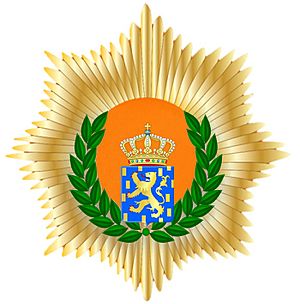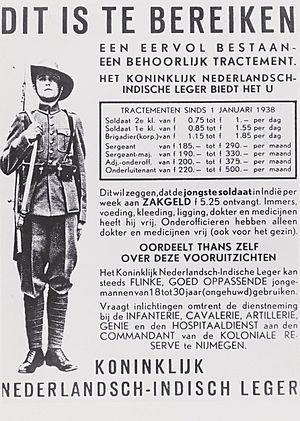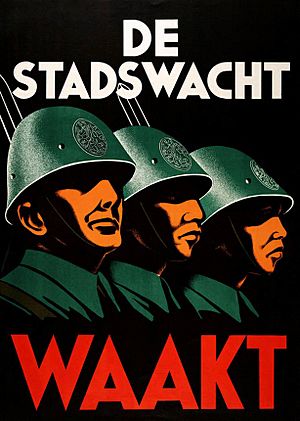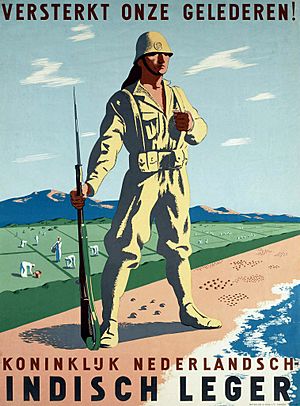Royal Netherlands East Indies Army facts for kids
Quick facts for kids Royal Netherlands East Indies Army |
|
|---|---|
| Koninklijk Nederlands Indisch Leger | |

Royal Netherlands East Indies Army coat of arms
|
|
| Active | 14 September 1814–26 July 1950 |
| Countries | Dutch East Indies |
| Allegiance | Netherlands |
| Type | Army |
| Headquarters | Bandung, Dutch East Indies |
| Nickname(s) | KNIL |
| Engagements | First expedition to Palembang 1819 Java War 1825–1830 Padri War 1821–1837 Expeditions to Bali 1846–1849 Expedition to the western section of Borneo 1850–1854 Palembang Highlands Expeditions 1851–1859 Banjarmasin War 1859-1867 Second Bone War 1859–1860 Dutch intervention in Lombok and Karangasem 1894 Kerinci Expedition 1903 Aceh War 1873–1904 World War II
|
| Commanders | |
| Commander | See list |
| Notable commanders |
Hein ter Poorten Simon Spoor |
| Aircraft flown | |
| Army Air Force | |
The Royal Netherlands East Indies Army (Dutch: Koninklijk Nederlands Indisch Leger; KNIL) was a special army. It was created by the Kingdom of the Netherlands. Its job was to protect and control the Dutch colony called the Dutch East Indies. Today, this area is known as Indonesia. The KNIL also had its own air force. Parts of the Dutch navy also helped in the East Indies.
Contents
History of the KNIL
Early Years (1814–1942)
The KNIL was officially started on September 14, 1814. It was not part of the main Dutch army. Instead, it was a separate force just for the Dutch East Indies. The KNIL helped the Netherlands expand its control over more land. This happened over many years.
The KNIL fought in many battles against local groups. These included the Padri War (1821–1845) and the Java War (1825–1830). They also fought in the Aceh War (1873–1904), which lasted a long time. In 1894, they took control of Lombok and Karangasem. This was because of reports that local rulers were treating the Sasak people badly. By the early 1900s, the Dutch East Indies was mostly peaceful. The KNIL then focused on defending the colony from outside attacks.
To make sure there were enough European soldiers, the Dutch government made military service required for European men living in the colony in 1917. Later, in 1922, a "Home Guard" was created for older European men.
World War II and Its Impact
In 1940, Nazi Germany took over the Netherlands. This made the Dutch forces in the East Indies much weaker. The KNIL could not get much help from the Netherlands. They tried to become a modern army quickly. Their goal was to protect the Dutch East Indies from invaders.
By December 1941, the Dutch forces had about 85,000 people. Most of these were local soldiers. The KNIL air force had 389 planes. But these planes were not as good as the Japanese planes.
During the Dutch East Indies campaign in 1941–42, the KNIL and other Allied forces were quickly defeated. Many European soldiers, including those of mixed European and Indonesian heritage, were captured by the Japanese. They became POWs (prisoners of war). A quarter of these prisoners did not survive.
Some KNIL soldiers, mostly local people, fought against the Japanese in small groups. These groups often fought alone. A few KNIL members managed to escape to Australia. In Australia, some local soldiers faced distrust. They were even held because of worries about their loyalty.
Later, some KNIL air force members formed new squadrons with the Royal Australian Air Force. During 1944–45, some KNIL ground units also fought in the New Guinea campaign and Borneo campaign.
In Australia, a camp was set up for a KNIL group. After Indonesia declared its independence, some Dutch soldiers in this group faced challenges with their Indonesian comrades. This led to difficult situations within the camp. Eventually, Australian authorities helped to send the Indonesian soldiers home.
After World War II (1945–1950)
After World War II, the KNIL tried to help the Netherlands take back control of Indonesia. They fought in two major military actions in 1947 and 1948. However, the Dutch efforts to regain their colony failed. The Netherlands finally recognized Indonesia's independence in December 1949.
In January 1950, some KNIL members were involved in a failed attempt to take over the city of Bandung. This event sped up the end of the federal Republic of the United States of Indonesia.
The KNIL was officially ended on July 26, 1950. Its local soldiers could choose to leave the army or join the new Indonesian National Armed Forces. However, there was a lot of distrust between the KNIL troops, many of whom were from Ambon, and the new Indonesian military, which was mostly from Java. This led to fighting in places like Makassar. About 12,500 Ambonese KNIL soldiers and their families moved to the Netherlands temporarily. After this, the KNIL stopped existing. Today, its history is remembered by a unit in the modern Dutch army. When it was disbanded, the KNIL had 65,000 members. About 26,000 of them joined the new Indonesian Army. The rest either left the military or joined the main Dutch army.
Who Joined the KNIL?
When the KNIL was first formed, it was planned to have both European and local soldiers. At first, the army had an equal number of both. But over time, there were more local soldiers than European ones. This was because not enough European volunteers joined.
The KNIL also hired soldiers from other countries in the 1800s. These were like mercenaries. During the long Aceh War, there were about 12,000 European troops. But up to 23,000 local soldiers were also used, mainly from Java, Ambon, and Manado. Some people from Africa were also recruited. About 60% of the troops were foreign or local, and 40% were Dutch.
After the Aceh War, the KNIL stopped hiring non-Dutch European soldiers. It then consisted of Dutch soldiers from the Netherlands, Indonesians, people of mixed European and Indonesian heritage (called Indos), and Dutch colonists living in the East Indies.
By 1884, the KNIL had about 13,492 European soldiers and 14,982 Indonesian soldiers. There were also some African and Eurasian recruits. All the officers were European. Each year, over 1,000 Dutch people and 500 foreigners joined. The foreign soldiers came from places like Germany, Switzerland, and France. People from the UK and USA were not allowed to join.
It was against the law to send Dutch young men who were required to serve in the military from the Netherlands to the East Indies. But Dutch volunteers still joined the KNIL. In 1890, a special group was set up in the Netherlands to recruit and train these volunteers.
Just before the Japanese invasion in December 1941, the KNIL had about 1,000 Dutch officers and 34,000 soldiers. About 28,000 of these soldiers were local. Most of these "native troops" were from Java and Sunda. During the Japanese occupation, most Dutch and Ambonese soldiers were held in prisoner camps.
During the Indonesian National Revolution, most KNIL officers were Dutch or Eurasian. But most of the regular soldiers were Indonesian Christians. These included people from Batak, Moluccas, Timor, and Manado. There were also some Muslim troops, but they were paid less. This caused some tension. The Dutch tried to use these differences to their advantage. They claimed that Ambonese people would lose their special benefits under an Indonesian government. This led to clashes between former KNIL units and the new Indonesian military in 1950.
Images for kids
-
Isaac Israëls, Het transport der kolonialen (Transport of the Colonial Soldiers), showing recruits for the Royal Netherlands East Indies Army marching through Rotterdam to their transport to the Dutch East Indies
Ranks of the KNIL
Officers
Other Ranks
| Rank group | Senior NCOs | Junior NCOs | Enlisted | |||||||||||||||||||||||||||||||||
|---|---|---|---|---|---|---|---|---|---|---|---|---|---|---|---|---|---|---|---|---|---|---|---|---|---|---|---|---|---|---|---|---|---|---|---|---|
(1942–1950) |
 |
 |
 |
 |
 |
 |
 |
 |
||||||||||||||||||||||||||||
| Onderluitenant | Adjudant | Sergeant majoor | Sergeant | Sergeant der 2e Klass | Korporaal | 1e Soldaat | Soldaat | |||||||||||||||||||||||||||||
Commanders of the KNIL
- 1815-1819 General-major Carl Heinrich Wilhelm Anthing
- 1819-1822 General-major Hendrik Merkus de Kock
- 1822-1828 General-major Josephus Jacobus van Geen
- 1829-1830 General-major Hendrik Merkus de Kock
- 1830-1835 Luitenant-generaal Hubert de Stuers
- 1835-1847 General-major Frans David Cochius
- 1847-1849 General-major Carel van der Wijck
- 1849-1851 Luitenant-generaal Bernhard of Saxe-Weimar-Eisenach
- 1851-1854 General-major Gerhardus Bakker
- 1854-1858 Luitenant-generaal François de Stuers
- 1858-1862 Luitenant-generaal Jan van Swieten
- 1862-1865 Luitenant-generaal Charles Pierre Schimpf
- 1865-1869 Luitenant-generaal Augustus Johannes Andresen
- 1869-1873 Luitenant-generaal Willem Egbert Kroesen
- 1873-1875 Luitenant-generaal Nicolaus Whitton
- 1875-1879 Luitenant-generaal Gillis Pieter de Neve
- 1879-1883 Luitenant-generaal Huibert Gerard Boumeester
- 1883-1887 Luitenant-generaal Karel Lodewijk Pfeiffer
- 1887-1889 Luitenant-generaal Anthonie Haga
- 1889-1893 Luitenant-generaal Theodoor van Zijll de Jong
- 1893-1895 Luitenant-generaal Adriaan Gey van Pittius
- 1895-1897 Luitenant-generaal Jacobus Augustinus Vetter
- 1897-1900 Luitenant-generaal Lammert Swart
See also
 In Spanish: Real Ejército de las Indias Orientales Neerlandesas para niños
In Spanish: Real Ejército de las Indias Orientales Neerlandesas para niños
- Royal Netherlands East Indies Army Women's Corps (VK-KNIL) — a special group for women in the KNIL, from 1944 to 1950.
- British Indian Army — an army that had a similar role in British India.



















